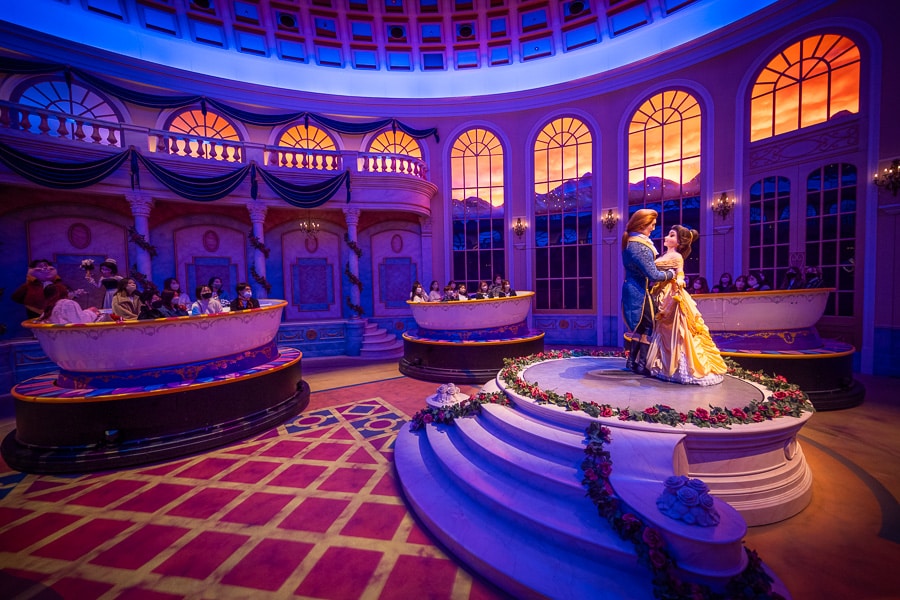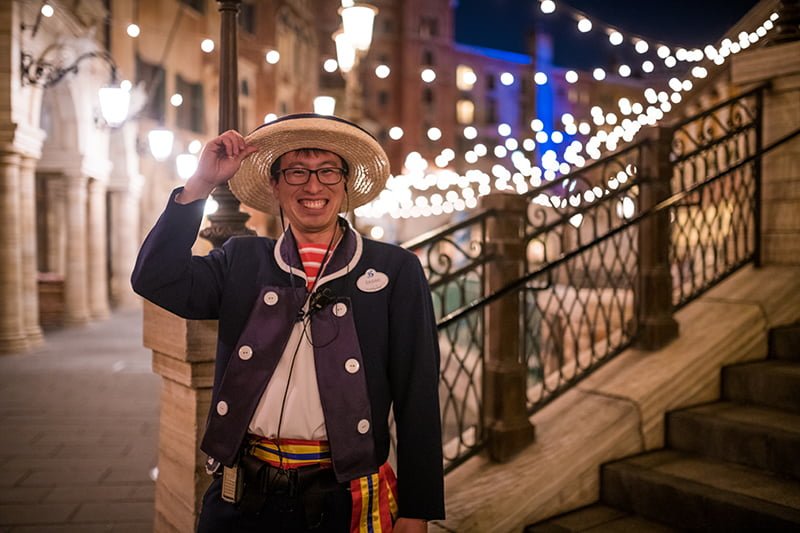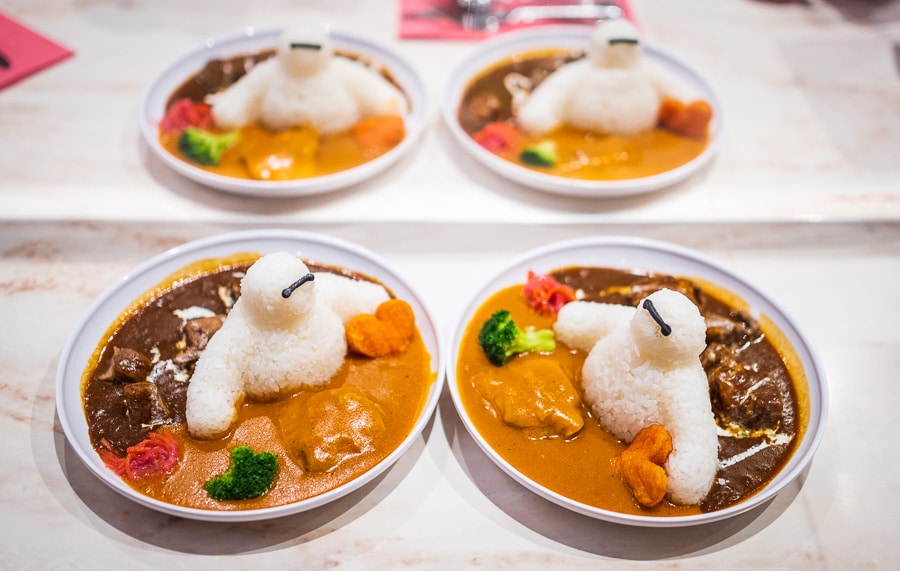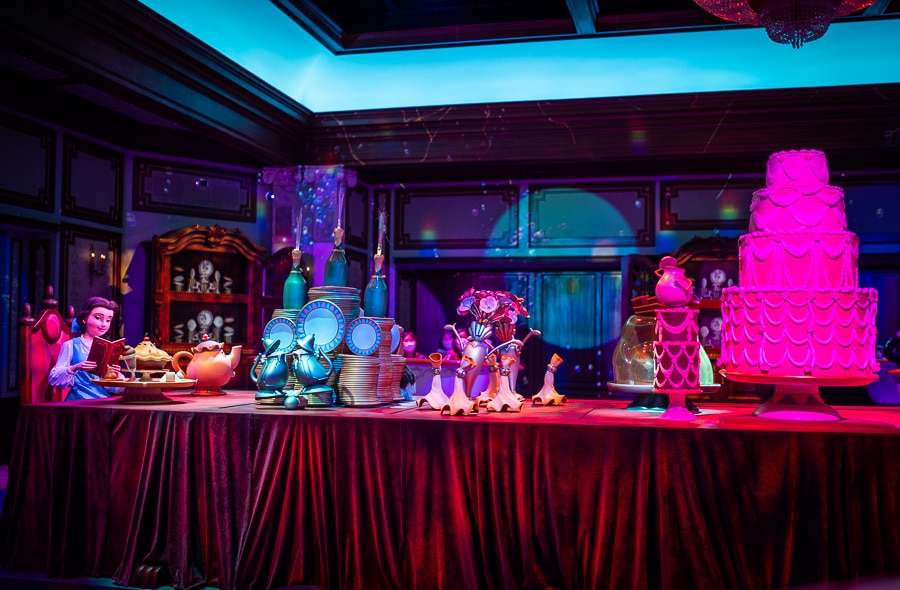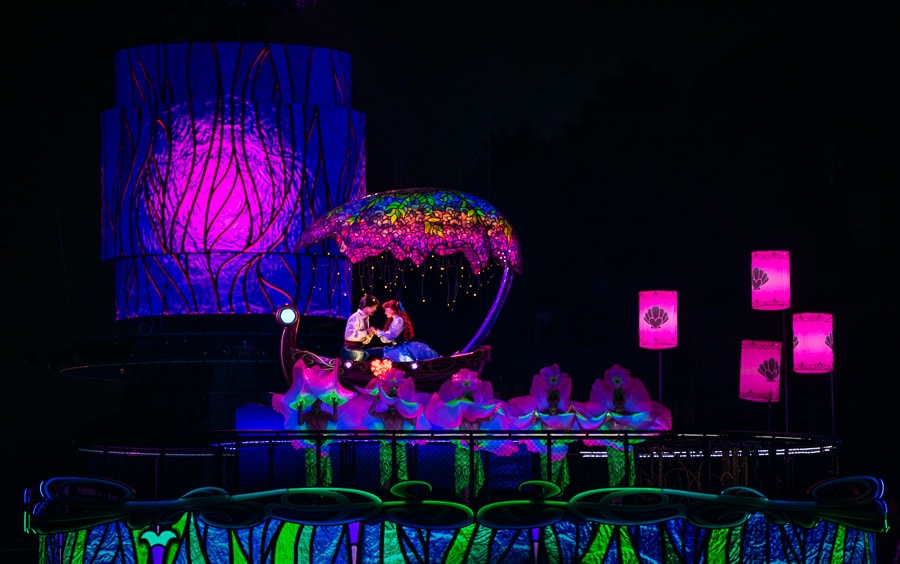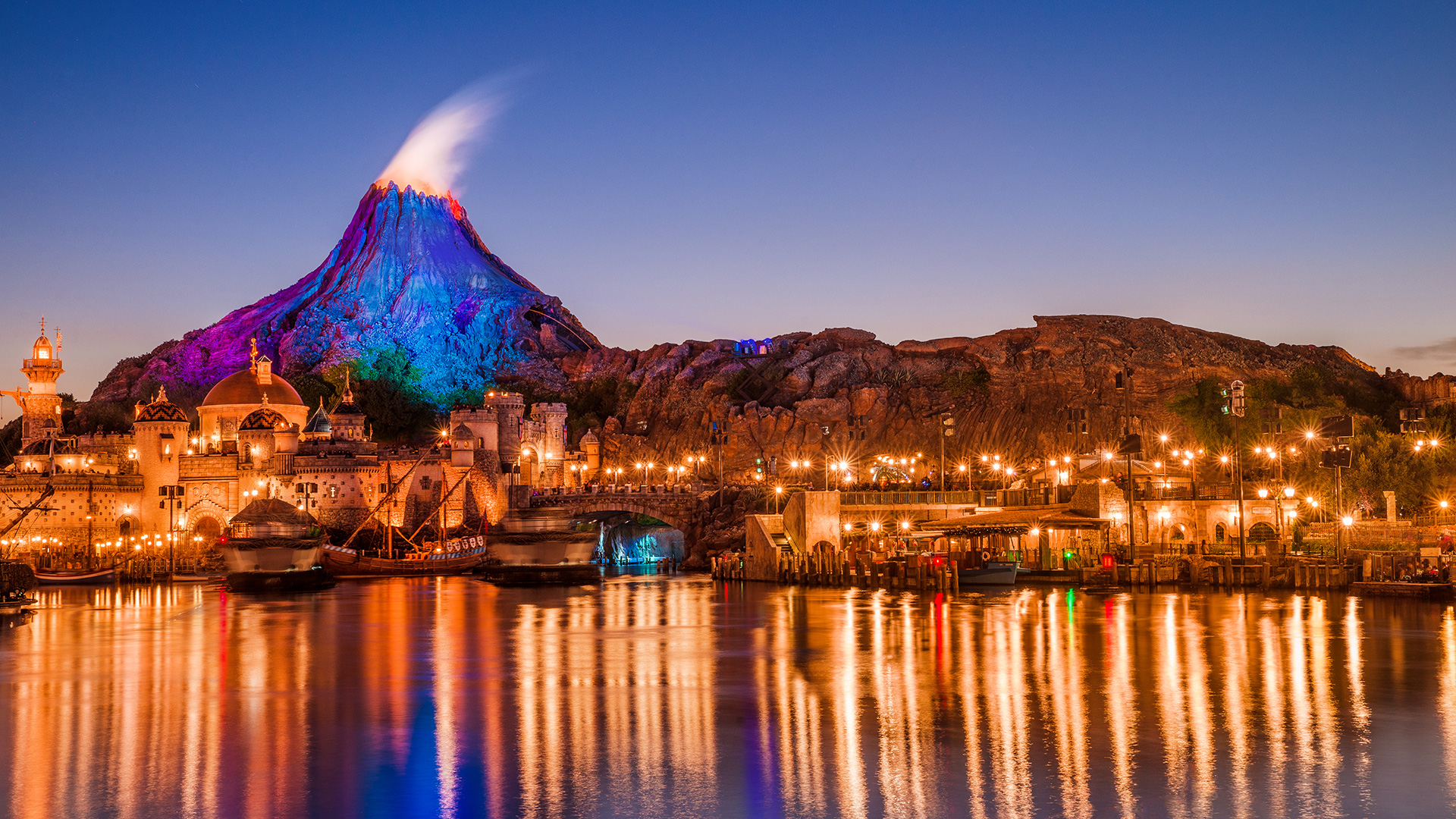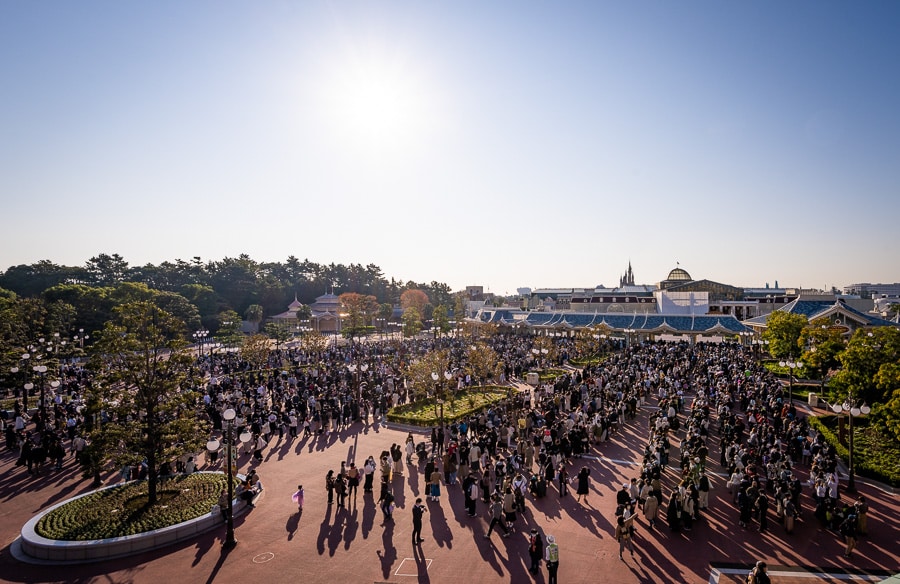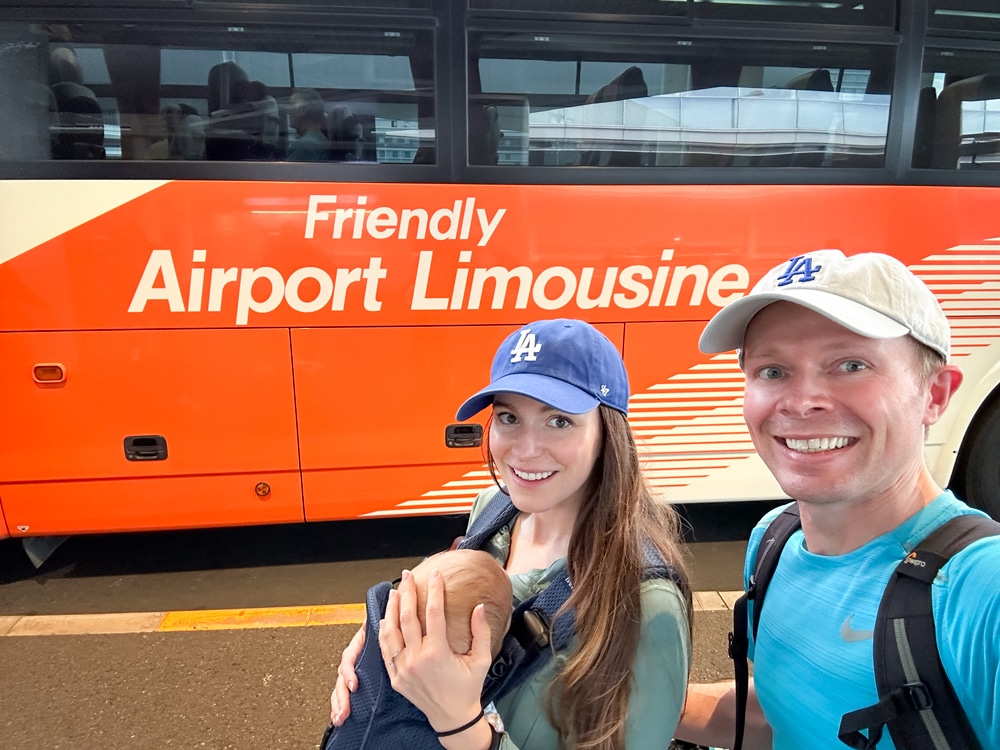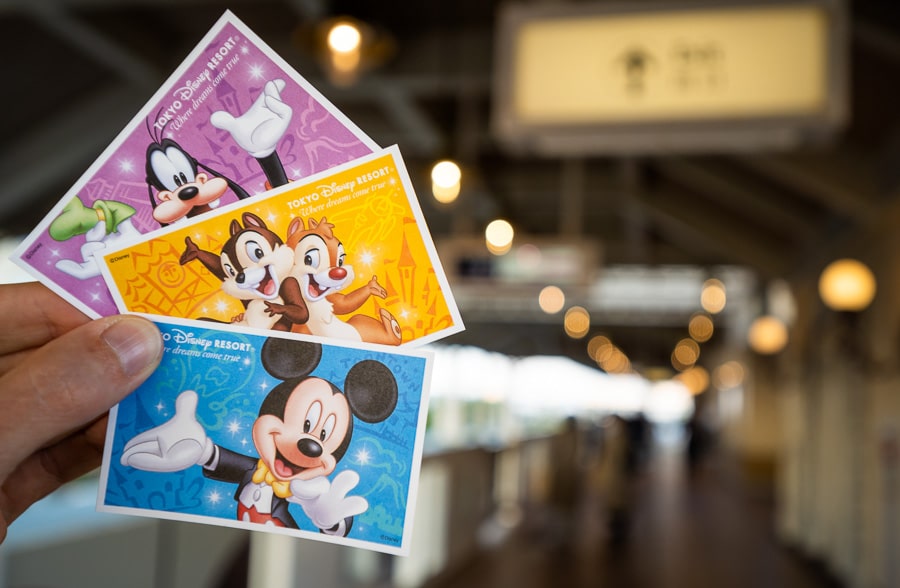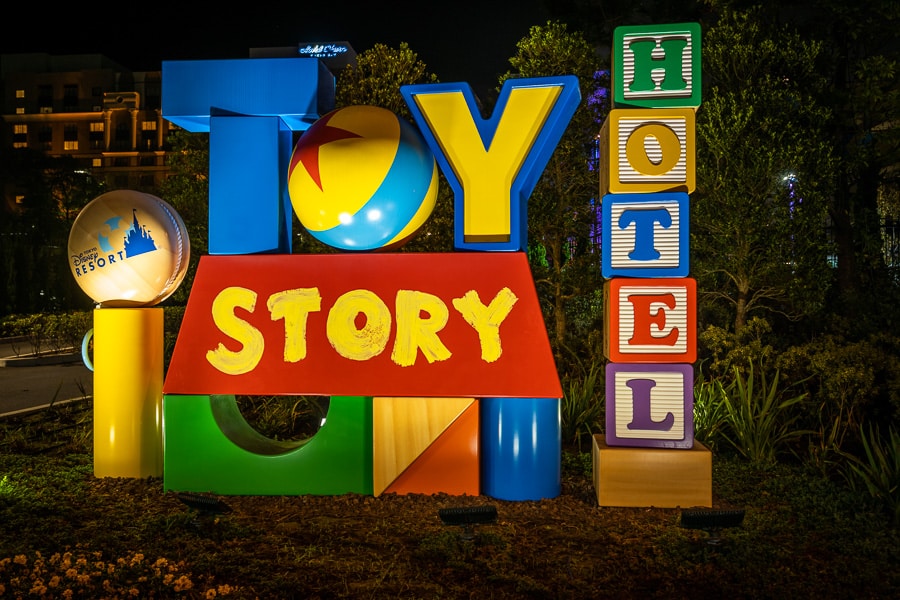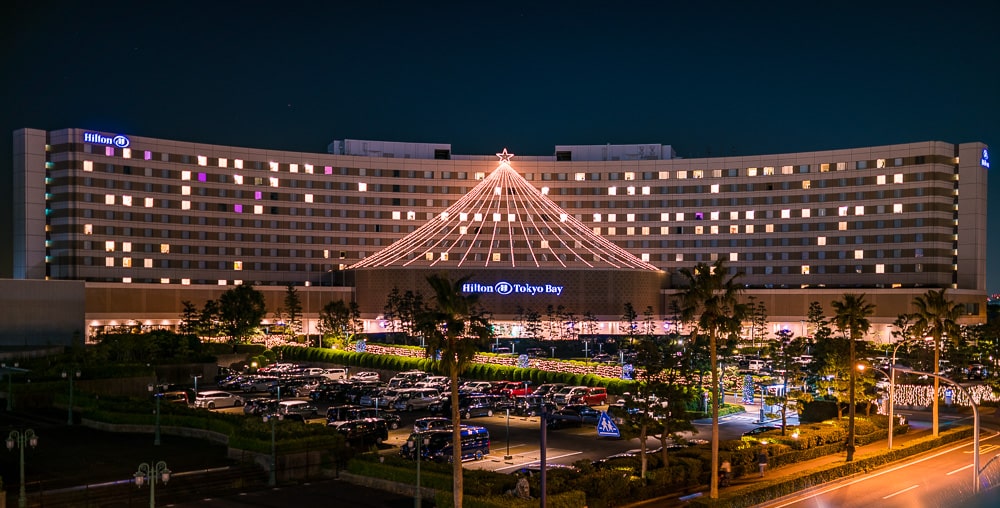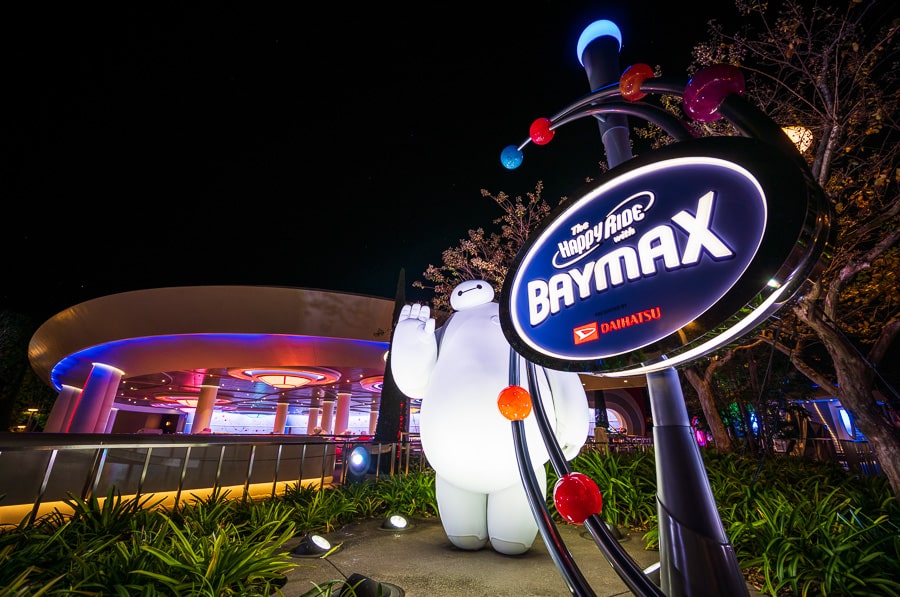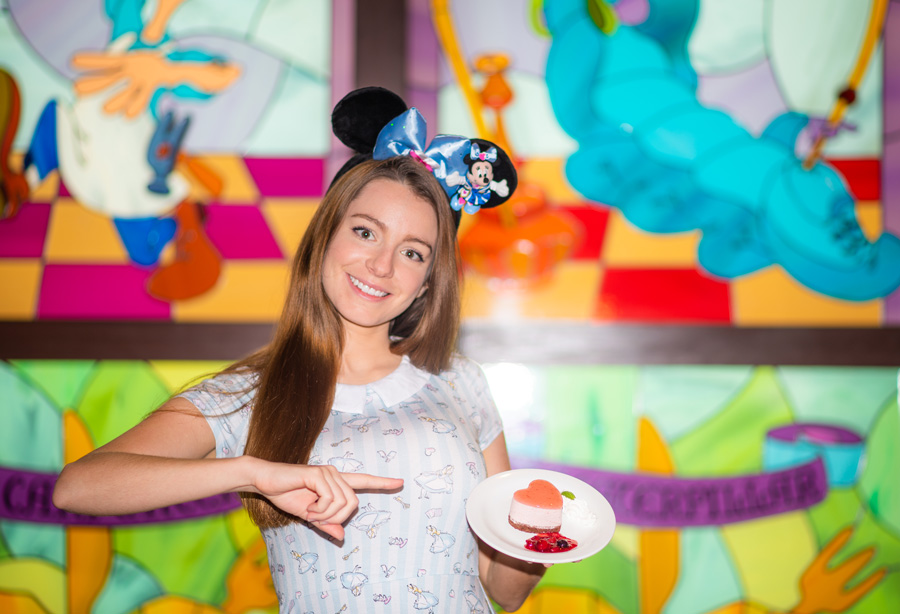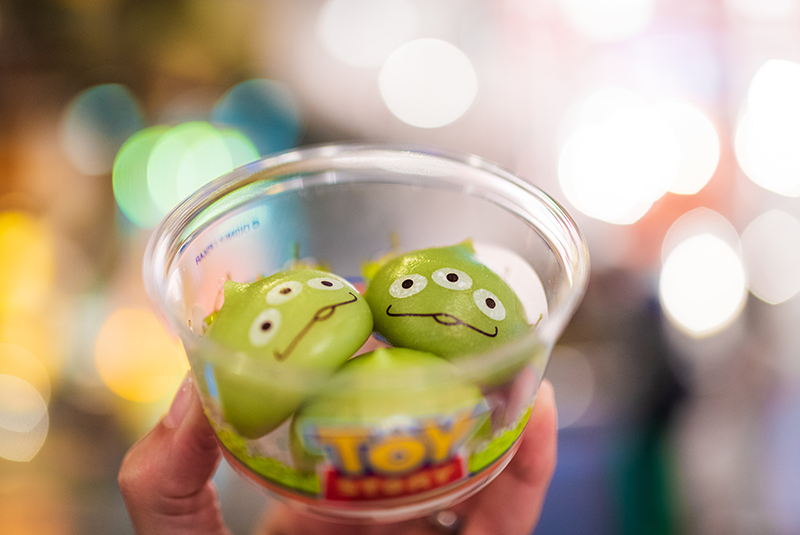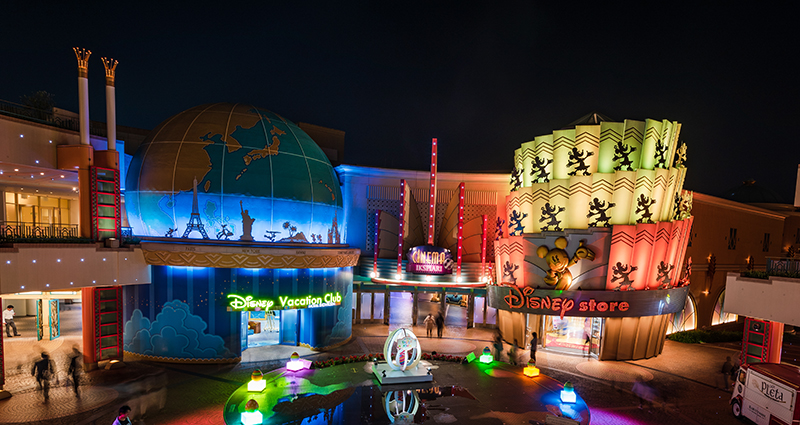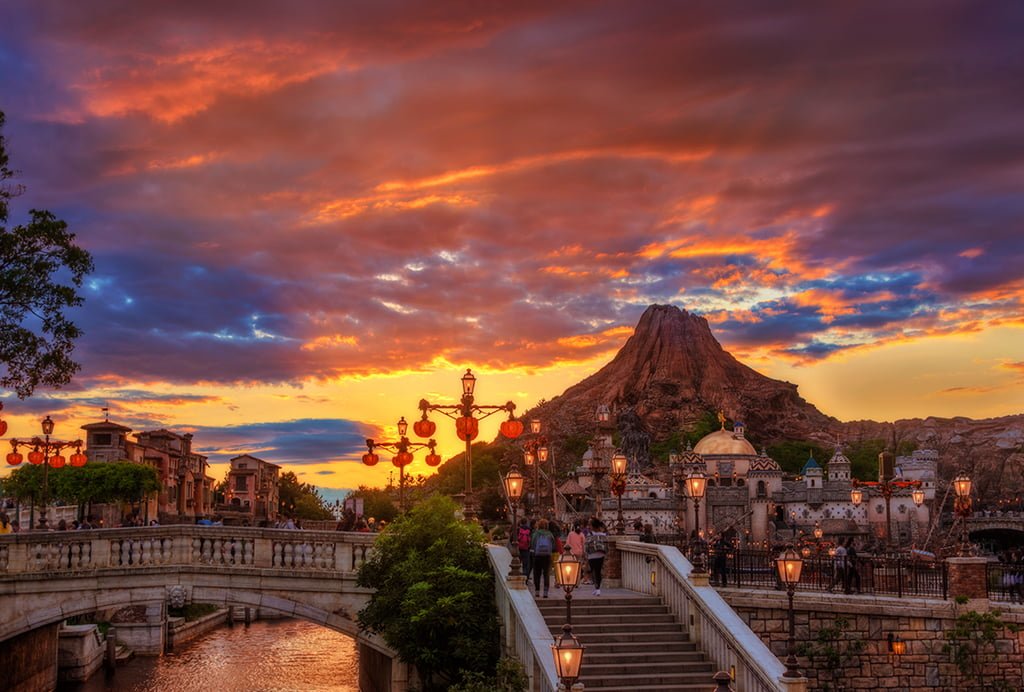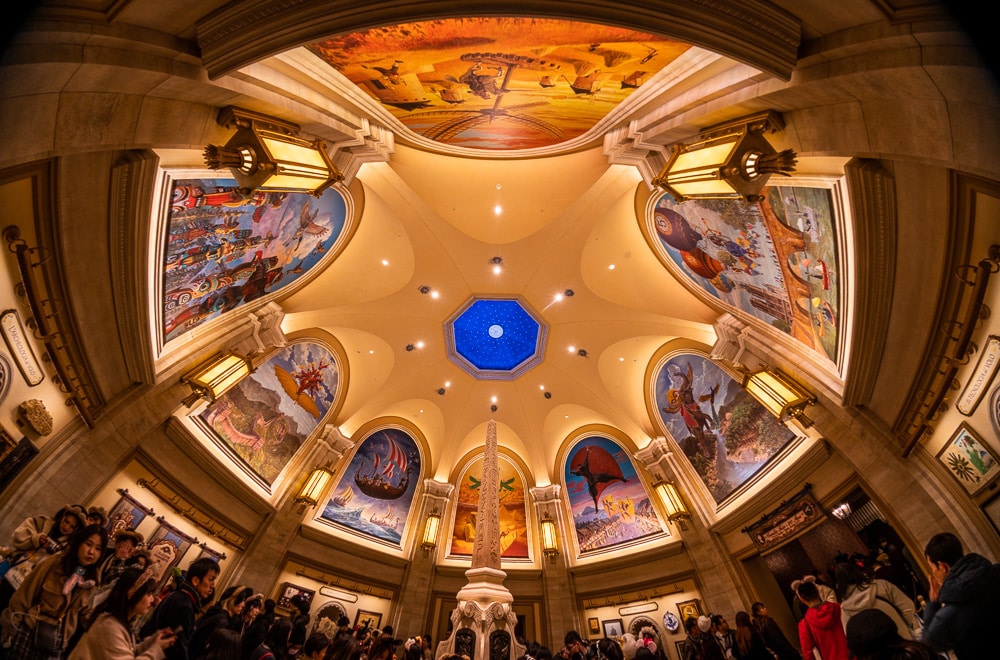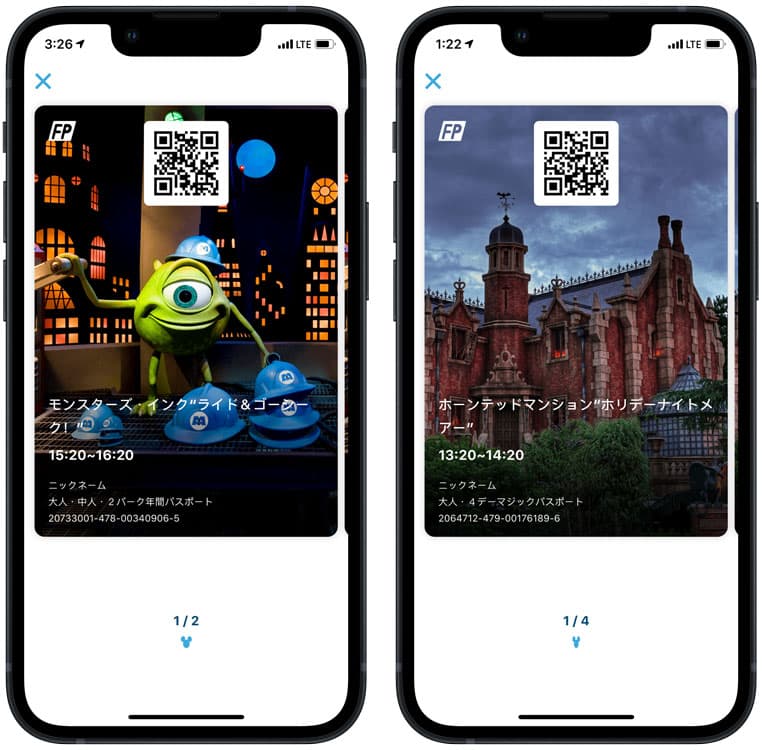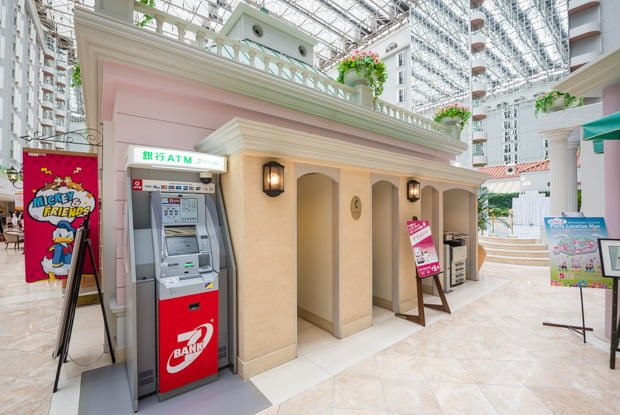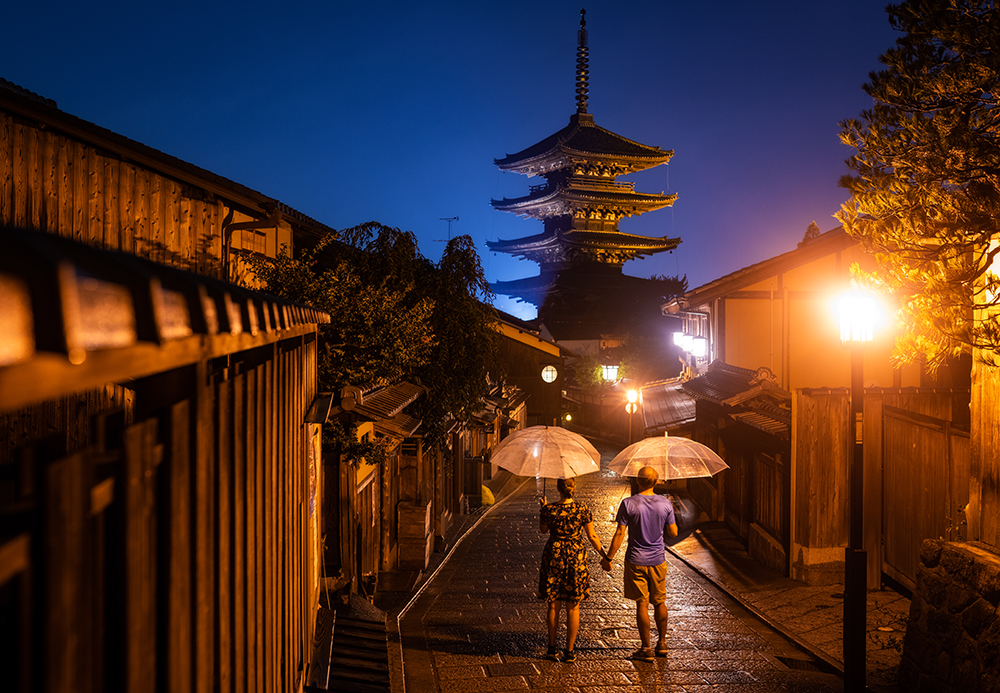Our 2025 Tokyo Disneyland & DisneySea vacation planning guide offers info for the two Disney parks, resort hotels, and ‘downtown’ district in Japan. We have tips & tricks, where to stay, how long to visit, must-eat food & snacks, best attractions, touring plans, avoiding crowds, and other things to do. (Updated May 1, 2025.)
Whether you’re eager to take your first visit to Japan or make a return visit for Fantasy Springs at Tokyo DisneySea, we are here to help you start planning! The brand new $2 billion port-of-call featuring Frozen, Tangled and Peter Pan is now open and is, unsurprisingly, very popular.
The good news is that Fantasy Springs recently switched to standby. You can now experience the attractions at Fantasy Springs in Tokyo DisneySea by waiting in line or by using Disney Premier Access (paid FastPass). This means that Anna and Elsa’s Frozen Journey, Peter Pan’s Never Land Adventure, Rapunzel’s Lantern Festival, and Fairy Tinker Bell’s Busy Buggies all ditched their virtual queues (called Standby Pass) and switched to regular ole standby lines. This is a huge change and one that’ll result in far fewer frustrations.
We had an awful experience attempting to enter Fantasy Springs at Christmas-time, which almost soured the day in Tokyo DisneySea for us. You can read Why Disney’s #1 Park is Getting 1-Star Reviews for a full recap, but suffice to say, we are far from alone in having these issues. This came after pretty smooth and seamless experiences with Fantasy Springs during the (slower) summer season.
Many guests were arriving at the entrance over an hour in advance and still aren’t getting to experience the headliner attractions in Fantasy Springs. These reviews and poor guest satisfaction are likely what caused Tokyo Disney Resort to rethink its approach to Fantasy Springs access. The good news is that this is a big improvement that adds predictability and reduces stress.
The bad news is that Tokyo DisneySea is still challenging, with long lines to enter the park at rope drop and high average wait times for most attractions. As such, we still recommend arriving early and packing your patience–or waiting out the rope drop crowd. Either way, you need savvy strategy for Tokyo DisneySea (even more so than Tokyo Disneyland) and, ideally, a willingness to purchase a few Premier Access line-skipping passes. We cannot emphasize enough how important advance planning is for Fantasy Springs and Tokyo DisneySea as a whole–and probably will throughout this year, 2026 and beyond.
It’s now been over two years since Japan reopened to individual travelers and we’ve been back to Tokyo Disney Resort on several occasions to experience everything that’s new and see how the parks have changed as compared to pre-closure.
Somehow, the phased reopening remains ongoing at Tokyo Disney Resort as of 2025–things still are not entirely back to normal. The way to think about operations at Tokyo Disney Resort is that they’re about 24 months behind the U.S. parks in their ‘phased reopening’ progress.
This is actually the dynamic throughout Japan, not just at Tokyo Disney Resort. Staffing shortages are an ongoing issue, restaurants and retail remain closed, entertainment is reduced or modified, hours are shorter, and more. The bottom line is that the Tokyo Disney Resort of today is still very different from the Tokyo Disney Resort of 2019.
If it’s your first visit, you probably won’t even notice this–Tokyo Disney Resort still has more (and better) entertainment than the U.S. parks. However, if you’re a repeat visitor, there are ways that the parks currently feel missing or incomplete. The good news is that this has gotten better already, and will likely continue to improve.
More positive progress will be made in 2025, albeit slowly. Tokyo Disney Resort has already announced the return of a show to the Hangar Stage in Tokyo DisneySea with “Dreams Take Flight” debuting on July 16, 2025. Additionally, the scaled-back Big Band Beat: A Special Treat will end on September 30, 2025…and hopefully something will replace it within the year.
Our expectation is that the target for improved operations and a more robust entertainment lineup at Tokyo DisneySea “Sparkling Jubilee” celebration, which starts next spring. See Tokyo DisneySea 25th Anniversary Dates & Details for more info about what that event will entail, our wish list for the celebration, and 3 timeframes we recommend visiting during the festivities.
In other positive news/updates, Tokyo Disney Resort brought back a version of free FastPass, albeit by a different name. Check out our Guide to Priority Pass & Premier Access at Tokyo Disneyland and DisneySea for everything you need to know about the new line-skipping services.
One thing to note right now is that there’s generally a disparity in crowds and wait times between Tokyo Disneyland and DisneySea, with the latter usually feeling far worse and having higher wait times. This is in large part because Tokyo Disney Resort attendance is driven disproportionately by locals, meaning repeat visitors as opposed to first-time foreign or domestic tourists.
Consequently, Fantasy Springs is driving attendance to Tokyo DisneySea on the one hand, as it’s the big new addition that locals want to experience. On the other hand, a new Space Mountain and Wreck-It Ralph ride are both currently being built, resulting in Tomorrowland at Tokyo Disneyland being a bit of a construction zone.
That plus refurbishments of popular rides is resulting in locals flocking to TDS and avoiding TDL. With this is mind, if you’re going to be more “aggressive” with getting up early or spend more on Premier Access, it makes sense to do that for Tokyo DisneySea. This could change as the year continues and more time passes since the opening of Fantasy Springs, but for now, it’s the dynamic.
For everything else that’s been recently added or is on the horizon, see What’s New & Next in 2025-2027 at Tokyo Disneyland & DisneySea.
Beyond that, a lot of other little changes have happened since 2019. A lot of this is covered indirectly via our 101 Great Tips for Tokyo Disneyland & DisneySea, which offers a wealth of random advice that will familiarize you with a ton of tips & tricks that you should know for navigating the quirks of Tokyo Disney Resort. Our goal with that post is to help first-timers and repeat visitors feel like they are touring the parks like locals. That covers a lot of things that are important but just too granular for a guide like this, such as:
Obviously, there’s a lot more ground covered than just those four bullet points. The salient point is that technology (the Tokyo Disney Resort app in particular, but not just that) has changed the game since 2019, as has the opening of Fantasy Springs. As a result, visiting TDR in 2025 is much different than it was 4 years ago.
With the latest updates out of the way, let’s dig into planning a trip to Tokyo Disneyland and Tokyo DisneySea…
We’ve spent a ton of time in Japan over the last decade-plus, and update this almost neurotically as we learn from our travels and research. This Tokyo DisneySea and Tokyo Disneyland Guide has been refreshed dozens of times since we first wrote it, and more will be added over time as certain parts are clarified or expanded. We are slightly obsessed fans of Tokyo Disneyland and DisneySea.
Prior to the closure, we visited Japan multiple times per year for 7 consecutive years, including several multi-month stays. We were Tokyo Disneyland & DisneySea Annual Passholders (until TDR cancelled those) who have dined in almost every restaurant and stayed in most hotels at Tokyo Disney Resort.
We recently spent over a month in Japan for our baby’s first trip trip, which included the opening of Fantasy Springs. Of course, we didn’t spend all of that time at Tokyo Disney Resort. The trip started with a week in Tokyo, followed by 3 weeks in Kyoto, before returning to Tokyo for a bit over 2 more weeks.
If you’re just starting to plan a trip to Japan, there’s a lot to consider. We recommend planning your time at Tokyo Disney Resort in tandem with where else you want to visit in Japan. Consult our Ultimate Tokyo, Japan City Guide for recommendations in the city. While we like Tokyo, we far prefer Kyoto.
Kyoto is our favorite city in the world, and a place that we view as essential to a trip to Japan. In our Ultimate Guide to Kyoto, Japan, we offer our “sales pitch” as to why we love it so much, and cover everything you need to know for planning a visit to that wonderful city. Total, we’d recommend Disney fans allocate around two-thirds of their trip to the cities of Kyoto and Tokyo–with more time in Kyoto.
Of course, all of this assumes that you should visit Japan in the first place. Let’s backtrack and address that threshold question…
If you have the means to go to Japan or can save for it as a once-in-a-lifetime trip, we think you will be very satisfied with the decision to go. While there’s no question that international travel is costly, traveling to Japan might not be quite as expensive as you might think; you really should crunch the numbers before ruling out the possibility of swinging a trip to Japan. Without question, it’s worth the money for Walt Disney World regulars to visit the Japan parks.
Since we visit Tokyo Disneyland and DisneySea regularly, we’ve been accused of being biased towards the Japanese parks. That isn’t true at all. We’re biased towards excellence. From maintenance to food quality to Cast Member friendliness, Tokyo Disney Resort is in a league of its own. Moreover, we have yet to encounter anyone who has told us they regretted visiting Japan. (If you want to be the first, feel free to say so in the comments.)
Without a doubt, traveling to Japan is outside comfort zones and one of the biggest things holding people back from visiting. From the long international flight to the prospect of navigating a foreign country without speaking its native language, a trip to Japan can be overwhelming. This is normal, and there’s absolutely nothing wrong with being anxious about traveling somewhere because it’s outside of your comfort zone.
Tokyo is a long flight to a place where English is a second language (at best). However, the Japanese are some of the universally nicest and most helpful people in the world. Once you understand the ‘system’ at one Disney theme park, you understand it at all of them, regardless of their dominant language.
In terms of the language barrier, there is not much of one at all. All signs are in English, park maps are available in English, and many attractions have dialogue in English. Even the attractions that have dialogue exclusively in Japanese mostly convey their message through visual means.
More importantly, most Cast Members either speak enough English to effectively communicate with English-speaking guests or can find someone to help you who does. Failing that, a bit of pantomime gets the job done. Verbal communication and pantomime with the first Cast Member you encounter is all you’ll need.
My social skills are poor and I can barely communicate with people in English, and I still do just fine. Irrespective of that, Cast Members in Tokyo are by far the nicest and most helpful in the world, and they will do everything they can to make your experience positive, so long as that does not involve breaking rules.
The Japanese concept of rules is different than the US concept of rules. Calling them “rules” might be a bit of a misnomer, because it some cases they’re inflexible policies. For example, you might be used to making substitutions to your meals in the US parks because of a food allergy or preference.
What’s on the menu is what’s on the menu in Japan, and attempts at substitutions or changes will typically be met with resistance or confusion. Americans are more likely to question the “why?” of a rule or policy here in the US and look at whether it really makes sense given the circumstances. In Japan, adherence to every rule/policy/procedure is universally expected, no matter how arbitrary it might seem.
Most of the time, this results in a more orderly, enjoyable experience. Only in Japan is there no line jumping, and everyone sits down for the parades! Sometimes it does have unintended consequences. We know some vegetarians who have gone to the parks and didn’t have the best of times because there were limited vegetarian options and they were unable to make substitutions because a substitution is going against established policy.
Part of answering this question requires determining how much time you can spend in Japan. If you’re traveling halfway around the world, hopefully you’re planning on seeing more than just the two Disney theme parks in Japan. In addition to these, we’d also strongly recommend spending a good amount of time in Tokyo and Kyoto at the very least.
The other part of answering this question is contingent upon whether you’re a Disney fan planning a pilgrimage to the two best Disney parks in the world, or a regular person visiting Japan who stumbled upon this post via Google. If the latter, two days is sufficient. We have itineraries below for seeing all of the highlights in a single day, and this guide is probably more than you want or need to know about Tokyo Disney Resort.
Those itineraries cover everything from the order you should do rides to experience them efficiently, to where you should eat, and more. Following those touring plans will help you make the most of your time in the parks and see as much as possible in only 2 days.
If you’re a diehard Disney fan wondering how many days you should spend at Tokyo Disney Resort…that’s a trick question. No number of days is enough…and that’s only a half-joke. Tokyo DisneySea is the best Disney park in the world and Tokyo Disneyland is also near the top (second best, if you ask me). Think of these parks as “fine moonshine.” You have to sip them slowly enough that you have a nice intoxication, because if you drink them in too quickly, you’re likely to go blind.
Hardcore Disney fans still should not overdo it, and should aim to spend no more than one-third of your trip to Japan at Tokyo Disney Resort–or a maximum of 4 days, whichever is less. Two days in each theme park might seem excessive, but we don’t think a trip to Tokyo is for the type of fan who views the parks as a collection of rides to “complete” as quickly as possible.
In our view, a balanced trip to Japan for a Disney fan includes 4 days at Tokyo Disney Resort, 3 days in Tokyo outside the parks, and 5 days in and around Kyoto. If anything, we’d be inclined to pull a day or two from the TDR and Tokyo portion of the trip to reallocate to Kyoto and other areas of the Kansai region (Osaka, Kobe, Nara, etc). Reasonable minds may vary on that, though.
These parks, DisneySea, especially, are meant to be slowed down and taken in. The best “attraction” at Tokyo DisneySea isn’t an actual attraction that you’ll find on any park map. It’s the sense of place that it has, and this is something that you’ll want to spend some time savoring.
When it comes to actual attractions, the lines can be long at both parks. These lines actually starting before the parks open, and guests running for popular attractions immediately. Tokyo Disney Resort’s main demographic is locals, and they don’t mind waiting hours in line for a single attraction because they can always come back later to see others.
Choosing the best time to visit is the most important aspect of planning a visit to Tokyo Disney Resort. We highly recommend reading our When to Visit Tokyo Disneyland post, as that covers this essential topic in much greater detail. Everything from weather (Tokyo has extremes in both directions–it can even snow there!) to seasonal events to crowds is discussed in that post.
When picking our days to visit Tokyo Disney Resort, the first thing we consider is what season we want to visit. For subsequent trips, we wanted to see Christmas, Halloween, Easter, and Pirates Summer. We’ve now visited during every season, and they’re all very well done.
Halloween and Christmas are the two most popular seasonal events at Tokyo Disney Resort, and the parks look awesome for both, with a lot of special seasonal entertainment. You can “double dip” by planning a HalloXmas Trip to Tokyo Disney Resort that coincides with both Halloween and Christmas. That’s our absolute favorite time to visit!
With it narrowed down to which season we wanted to see, think about crowds…
As with weather, Tokyo Disney Resort is a place of extremes when it comes to crowds. This makes it really important to choose the least-crowded dates. Once we choose the time of year we want to visit (see our ‘When to Visit’ post above for recommendations), we generally consult Crowd Calendars for Tokyo Disneyland and DisneySea to pick specific date ranges within the season that are predicted to be lightly crowded.
More important than the time of year is the days of the week you visit. Tokyo Disneyland and Tokyo DisneySea are least busy Monday through Thursday. Friday is the busiest weekday, and weekends are incredibly busy. Avoid weekends no matter what time of year you visit.
If you’re researching a trip, you might have encountered photos of insane crowds that make you apprehensive about visiting. Crowds in Tokyo Disneyland and DisneySea have taken on “urban legend” status as these photos spread. The reality is that weekends and holidays can be very busy.
On the other hand, low-season days in the middle of the week can feel more pleasant than mid-January at Disneyland. The crowds at these parks fluctuate more than any other Disney parks in the world, which really underscores the importance of carefully choosing days to visit.
For any Disney trip, the things on our Unique Disney Packing List will be helpful. There’s not really anything specific to Tokyo that you will need. No voltage converter is necessary. However, there are a few things you might want to pack for the long international flight.
Sarah had trouble sleeping on our first couple of flights to Japan, so she purchased these reusable earplugs, this sleep mask, and this inflatable airplane pillow. Now she swears by all 3. I could sleep on a pile of hay during a death metal concert, so I don’t use earplugs or a special pillow–just noise cancelling AirPods Pro.
If you’re visiting during the summer, things like Frogg Togg Chilly Pads will also come in handy, as will moisture wicking clothing because Japan gets really humid in June, July and August. Consult our Beating the Summer Heat at Disney post for more info. In the winter, it’s cold and can even snow in Japan, so read our Packing for Disney in Winter post for tips on visiting then.
Outside of the summer, guests in Tokyo Disney Resort typically dress very nicely, which is something to keep in mind when packing your own clothes. Novelty Disney hats are also common with these nice clothes (quite the contrast), but you’ll want to buy your novelty hat in the parks.
We would caution against overpacking. This is especially true if you’re doing more in Japan than just Tokyo Disney Resort. The rail system in Tokyo is incredibly complex, with a lot of transfers. You will do a lot of walking, riding the rail, etc., and you really don’t want to be encumbered by excess baggage, especially during rush hour on the trains.
Perhaps the best advice we can give you is to pack light. Lay out everything you’re planning on taking before you pack it, and determine if you truly need it. Not if it “might come in handy, maybe,” but if you actually will use it. Don’t pack things you won’t use. If you are going to be staying in multiple hotels during your trip to Japan, we recommend packing cubes or compression bags for organization. You can read more of our “carry-on philosophy” and which types of bags we use here.
There are several ticket options at Tokyo Disney Resort, we discuss them in more depth in our Money-Saving Tips for Tokyo Disneyland Park Tickets post. If you are going on weekdays during non-holiday season, the easiest option is purchasing your park tickets on the day-of at the front of Tokyo Disneyland and Tokyo DisneySea. However, this isn’t without risk, as tickets can and do sell out for popular dates.
In an ideal scenario, you should buy tickets online about 30-60 days in advance of your trip (tickets are not currently sold beyond 60 days out) to avoid any issues upon arrival. To save money and buy tickets before leaving home, we recommend Klook (if they have inventory–which isn’t always the case). Not only are their tickets discounted, but it’s easier to navigate than the official (and more expensive) Tokyo Disney Resort website.
If Klook is sold out, we recommend using the official Tokyo Disney Resort Online Reservation & Tickets website or the TDR app. Fair warning: these can be difficult to use, and often have issues with credit cards issued by U.S. banks.
Failing all of that, you can wait until you arrive to purchase your park tickets. Just be warned that Tokyo Disney Resort does sell out of park tickets in advance. However, guests of monorail loop hotels (like the Sheraton and Hilton Tokyo Bay) may usually purchase tickets from their hotel’s concierge even when the parks are sold out to the general public.
(This was guaranteed pre-2020, but has become much more hit or miss. Even though the Hilton no longer advertises it online, they typically do have tickets available. We just confirmed this again at Christmas. It’s still true.)
We have stayed at 10 different hotels in and around Tokyo Disney Resort, plus Airbnb apartments. Suffice to say, we have a lot of experience at hotels in Japan, and almost all of it is positive. For our thoughts on hotel options, read our Hotel Reviews & Rankings at Tokyo Disneyland post, as that covers the topic in greater depth, and provides links to specific hotel reviews.
As for an overview, you basically have three options: off-site, on-site “official,” and on-site Disney. We’ll start by covering the Disney hotels. These are Disney’s Ambassador Hotel, Tokyo Disney Celebration Hotel, Tokyo Disneyland Hotel, Hotel MiraCosta, Toy Story Hotel, and Fantasy Springs Hotel.
They are all very pricey. If you have the money, consider a night or two at Hotel MiraCosta or Tokyo Disneyland Hotel. We’ve stayed at both, and they are two of the most unforgettable hotel experiences we’ve ever had. (We have not yet stayed at Fantasy Springs Hotel, but we have toured it. We were unimpressed.)
If you’re approaching them solely from a cost-benefit or value perspective, it’s difficult to justify any of the Disney hotels. Their big advantage is location, and that’s biggest in terms of the view from your room (which can be into the park at both Tokyo Disneyland Hotel and Hotel MiraCosta) and not from access, since the on-site official hotels are also located on the monorail loop and also have theme park views in some cases.
Is it worth potentially $200-300/night more than the official hotels for that view into the park? Probably not, unless money is no issue or you’re viewing this as a once in a lifetime trip.
As for the on-site official hotels, these are hotels that are on the monorail loop, and typically offer large, Western accommodations, and are moderately priced given the circumstances. Many compare very favorably to a Walt Disney World Deluxe hotel. Large, nice rooms. Cinderella Castle or ocean views. Location on the monorail loop. All for $130-180/night, most of the time. (Prices do spike for these hotels certain times of year and at the last minute, so book early.)
Finally, there are the off-site hotels, which we do not recommend. There’s nothing wrong with a lot of the off-site hotels, but they are a more unknown quantity with rooms that will typically skew towards small, Japanese accommodations. Plus, many of the ones closest to Tokyo Disney Resort are overpriced considering what they offer.
There’s also the element of getting to and from the parks on public transportation, which can be a real hassle. Public transportation is also utilized by business people and students around the same time you’ll be heading to the parks, making it chaotic.
If you must stay off-site because the on-site hotels or full, or because you’re on a tight budget, we highly recommend doing an Airbnb rental instead…
We have a post that discusses our Tips for Using Airbnb in case you’re unfamiliar with the service. We’ve used it numerous times in Japan, near Tokyo Disney Resort as well as in Kyoto and Osaka. We typically use it on Friday and Saturday nights near Tokyo Disney Resorts, as hotel rates typically skyrocket for those nights.
When we are traveling throughout Japan but aren’t at Tokyo Disney Resort, we prefer Airbnb to booking hotels because it gives us the option for a much larger room, usually an entire apartment. Japanese hotel rooms (that are not Western chains) tend to be very small, and using Airbnb is the best way to avoid this issue.
Plus, the price is usually cheaper than a hotel room, and Airbnb hosts often include free MiFi so you can use the internet on the go. We’ve had some fun experiences staying at unique Airbnb locations throughout Japan, too. (The photo above is from an Airbnb we rented in Japan that was converted from a bar downstairs.)
Even if you go at a less-busy time of year, we recommend arriving at either park 30 minutes before it opens for your first couple of days. There will already be a long line (or lines) to get inside when you get there, so don’t be alarmed. Once you get inside, walk briskly (or run lightly) for your first ride of the day.
This is covered in the strategy guides above, but it’s good to reiterate. Once you knock out the main headliners, you can take the ‘sleep in and go late’ approach, on subsequent days if you so desire–but your first day in each park you should arrive prior to opening.
We’ve already written extensive attraction guides for both parks, so there’s no point in rehashing those here. Those guides contain strategy as well as reviews of the attractions. There will be very few attractions you’ll want to skip in Tokyo DisneySea, perhaps more in Tokyo Disneyland (where there are more clones). Here are those guides:
Refurbishments are common at Tokyo Disney Resort, so make sure you consult the Tokyo Disney Resort Refurbishment Calendar before booking. It’s good for about 6 months out, so it may not be of much help.
Dining at Tokyo Disney Resort is a huge topic unto itself, and this guide is already getting really long, so this will just cover the basics. First, for specific restaurants, make sure to check out our Tokyo Disney Resort Restaurant Reviews.
We have individual reviews from every Tokyo Disney Resort restaurant, plus restaurant rankings for both parks. We’ve eaten at every single restaurant in the parks, plus many in the hotels and Ikspiari, so that should help.
Snacking should be a big part of your trip. The cost of this can quickly add up, but it’s an integral part of the Tokyo experience. Tokyo Disney Resort has some crazy popcorn flavors, and they’re definitely worth trying so you can form your own opinion.
We also like stopping for full meals. In our experience, Tokyo Disneyland is the place to do counter service and Tokyo DisneySea is the place to do table service (its counter service options are also good, though). Both parks have some really amazing restaurants that are experiences in themselves.
The Tokyo parks have a reputation for small portion sizes and high prices, but that’s hit or miss. Portions can be small, but they aren’t always. We think prices are comparable to the US parks for counter service meals (for similar portion sizes and quality), and table service is cheaper at Tokyo Disney Resort. There’s no tipping (and it’s a strict rule–they won’t let you tip) in Japan, which plays a part in the price differences.
If you do plan on doing table service, know that restaurants often are fully booked in advance. Unfortunately, the only way to make dining reservations is through the Tokyo Disney Resort website (in Japanese) or by emailing the hotel if you are staying at a Disney-owned hotel.
As mentioned above, substitutions are not a ‘thing’ in Tokyo, nor is accommodating those with special dietary needs or preferences. If you are a vegetarian, dining in the Tokyo parks will be a challenge, as there are limited vegetarian menus. If you have other restrictions or preferences, you may have an even more difficult time.
Neither of us are vegetarians so we have no first hand experience in this regard, but we’ve heard stories from others. If you are a vegetarian, the buffets are your best option, but vegetarian options at counter service restaurants are starting to become more common.
Merchandise at Tokyo Disney Resort is very different from what you’ll find at Walt Disney World or Disneyland. Instead of items with the park logos or attraction names, most items at Tokyo Disney Resort are character-themed or kawaii. Depending upon who you ask, Tokyo either has the best or worst merchandise of any Disney destination in the world.
It’s worth noting that in the last few years, Tokyo has increased the amount of logo merchandise and either things appealing to broader tastes. We’ve found ourselves “embracing the kawaii” of Tokyo Disney Resort’s merchandise more and more, but it’s definitely an acquired taste that isn’t for everyone.
On your arrival or departure day, consider visiting Ikspiari, which is a dining, shopping, and entertainment complex located within walking distance of Tokyo Disneyland, the JR Maihama railway station, and with its own monorail station. It’s Japan’s take on the Downtown Disney concept.
Ikspiari has over 150 restaurants and retail shops, the highlights of which we cover in our Shopping Guide to Ikspiari at Tokyo Disney Resort. Note that while we referred to Ikspiari as Tokyo Disney Resort’s twist on Downtown Disney, it is decidedly not Disney. Oriental Land Company purposefully developed Ikspiari without Disney branding to avoid paying licensing fees.
For those who are big into shopping and want to do some of that in Japan, we’d encourage you to do so in Tokyo proper. Literally every major train or subway station in Tokyo has an above or underground labyrinth of retail and dining. Highlights can be found in the chic storefronts of Ginza and Roppongi Hills, and the otaku items of Asakusa and Harajuku.
However, none of these places will be as compelling for Disney fans as Nakano Broadway, which is full of second-hand stores that cater to collectors and geeks, including Disney fans! We visit Nakano Broadway frequently to buy great Tokyo Disney Resort collectibles. For more info & tips, see our Shopping Guide to Nakano Broadway on our non-Disney blog, TravelCaffeine.com.
Flights to Tokyo from the United States are 10+ hours, which is a lot of time in the air. Fortunately, the larger planes used for these flights are much more comfortable than your normal planes used for domestic flights. Complimentary in-flight entertainment (including the latest movies and television shows) also makes things easier.
If you know your travel dates and have no flexibility as to when you travel, we recommend ITA Software to search for flights. ITA is the best way to find the lowest prices on airfare for set dates of travel. Either HND or NRT will work as arrival airports. HND is located closer to the city center, whereas NRT is (slightly) closer to Tokyo Disney Resort, but farther from downtown.
If you’re in the preliminary stages of researching your flight, use fare alerts on Airfarewatchdog.com. You can set some parameters for the alerts here (although not as many as I’d like) and receive email updates when they deem prices to be low.
Airfare prices are always changing and are highly dependent upon city of origin, time of year, etc., but with round-trip airfare out of Los Angeles to Tokyo regularly in the <$600 range, your complete airfare package should cost under $1,000/person if you put effort into choosing the right times to travel. If you’re booking at the last minute or don’t do any work to find deals, the sky is the limit on the upper end of airfare pricing.
If you are looking for a way to get more bang for your buck, you can use it to add stopovers to visit multiple locations. We cover this in our “How to Visit 3 Disney Destinations on 1 Airfare” post. It might seem complicated at first, but it is well worth reading that post and figuring it out. That post covers how to incorporate Shanghai Disneyland, Hong Kong Disneyland, and Tokyo Disney Resort into a single trip.
That covers airfare. Now for using ground transportation in Japan…
Out of all of the cities in the world we’ve visited, Tokyo has by far the most complicated transportation network. This should come as no surprise, as it’s the world’s largest city. However, improvements to Google Maps since we’ve started visiting have made this a breeze. (Google now has crowd predictions for trains at different times of day, and recommends certain ones to take!)
To get from either Tokyo airport to Tokyo Disney Resort, it’s relatively easy. You just take the Airport Limousine Bus, which you catch outside the airport after purchasing your ticket near the exit at a desk or the ticketing machine. It’s more expensive than public transit, but easier and direct. Note that while this bus runs regularly, its schedule generally stops around 5 p.m. Here’s the full schedule to TDR from Narita. If your flight arrives into Tokyo after 4 p.m., you should probably look at other options.
If you’re getting in really late, the easiest alternative is a taxi. These are waiting outside the airport and easy to find. The downside is price. Our understanding is that the cost of a taxi to a Tokyo Disney Resort area hotel from Narita is $200.
The cheapest alternative is to use public transportation. It’s intimidating at first, as Japan’s public transportation system is very complex, but we ultimately have had no issues and it’s a relatively straightforward route from the airports to Tokyo Disney Resort. Just use Google Maps.
Getting around Tokyo Disney Resort, you’ll want to take the monorail. It costs money, but it’s efficient, reliable, and clean. (That all might sound bizarre to Walt Disney World fans…especially the “reliable” part!) There are also Resort Cruisers, which are buses, that are free of charge. Just pay the minor fee for the monorail unless you have a large party. It’s fun and totally worth it. Walking is also an option, although it can be convoluted to get to Tokyo DisneySea.
There are three good options for this: renting a SIM card, renting a pocket WiFi/MiFi, or using your carrier as normal. We now use T-Mobile and simply use that as there’s no additional charge to use our data in Japan. It runs a bit slower, but we’ve found it perfectly usable for regular internet browsing. It’s becoming more common for cellular providers to offer international day passes that are comparably priced to MiFi, so check out that.
Renting a SIM card is a great option for some people, but we really liked the MiFi rental for our trips prior to switching to T-Mobile. For those unfamiliar with the device, it’s basically a pocket WiFi hotspot, providing you with unlimited LTE internet. MiFi/Pocket WiFi rental is pretty easy. You simply choose how many days you want to rent, how many devices, and specify at which airport you’ll want to pick it up.
We recommend renting one MiFi per person in your group, so you can communicate if you separate. If you will not–under any circumstances–separate, just get one MiFi. A single MiFi can handle a few phones on it simultaneously. We highly recommend renting in advance of your trip. If you wait until you arrive and simply pick one up from the shops at the airport or at a convenience store, prices are higher and data is typically limited.
While the internet can sometimes be spotty in Tokyo DisneySea, the MiFi overall is really reliable. We’ve used it regularly for iMessage for communicating with one another, email, Dropbox, and even uploading to YouTube. Most importantly, having the MiFi gave us the ability to use Google Maps on our phones for public transportation, and this was a huge lifesaver.
There is no publicly-available WiFi internet at Tokyo Disney Resort, except at the entrance to each park. Free public WiFi is uncommon in Japan. (By contrast, it’s very common in Hong Kong, if you’re going to both.)
Tokyo Disney Resort (and most Japanese retailers) accepts standard US magnetic strip credit cards, or chipped credit cards. Chipped cards aren’t required. With the parks, Tokyo Disney Resort accepts Visa, Mastercard, and American Express. (If you’re trying to pre-book something online, you’ll need a credit card issued in Japan or a Mastercard. Even then, it can be a painful process.)
If you need an ATM, there are two at Tokyo Disney Resort that accept American Visa debit cards. One is in the basement of Ikspiari near the food court, and the other is in the lobby of the Tokyo Bay Maihama Hotel Club Resort (pictured above). If you’re staying at one of the official hotels on the monorail loop, the second location is going to be far more convenient to you. Typically, you do not need to carry cash at Tokyo Disney Resort, but you might need it in the city of Tokyo.
For general travel advice to Japan, we have another blog: TravelCaffeine.com, where we share our non-Disney experiences. We have written extensively about our favorite city in the world: Kyoto, Japan on TravelCaffeine. Kyoto has something for everyone, and offers a lot in terms of Japanese culture and history. As mentioned above, our Ultimate Guide to Kyoto, Japan also provides a wealth of planning information.
If you’re also visiting the Hong Kong or Shanghai parks, make sure to consult our Hong Kong Disneyland Trip Planning Guide and our Shanghai Disneyland Trip Planning Guide. There’s a lot more you’ll need to know for those visits!
There’s a lot more we could include in this guide, but this is already the longest post on the blog to date, so let’s cut it off there. We will definitely add to this based on common questions, and I’m more than happy to offer assistance and advice in the comments if you have questions. Want to see more photos or read about Tokyo Disney Resort in agonizing detail? Check out our Tokyo Disney Resort Trip Report from our very first visit to Japan over a decade ago, when we too were newbies!
Planning a trip to Japan is a lot of work, but it’s ultimately well worth the effort! Hopefully this guide provides a good jumping off point. If you’ve visited Tokyo Disney Resort, do you agree or disagree with our advice? Any questions? Hearing your feedback–even when you disagree with us–is both interesting to us and helpful to other readers, so please share your thoughts below in the comments!
Hi,
We recently visited Tokyo Disneyland and DisneySea. While both parks are great in their own right, they just don’t compare to Disney World in Orlando, Florida. For us, Disney World is in a league of its own—our undisputed favorite! I know the saying goes “De gustibus non est disputandum” (there’s no arguing about taste), but we’ve heard people claim that Tokyo Disney Resort is the best in the world… we respectfully disagree. For the record, we’re not from the U.S. or Japan, so there’s no national bias here. Ironically, the Disney park we like the least is our local one in Paris—unfortunately, it just doesn’t measure up.
We spent 2 days in DisneySea and 1.5 days in Disneyland, which we found to be more than enough—especially since we used Disney Premier Access (DPA) at both parks. If you’re short on time or don’t plan to use DPA, you absolutely must plan ahead. These parks are intense! The density of people compared to the available space makes it very hard for crowds to spread out. It often feels like “Everything Everywhere All at Once” is happening around you!
We didn’t do much advance planning and mostly relied on ChatGPT for quick scheduling suggestions. We leaned heavily on DPA—it was super helpful but undeniably expensive. Was it worth it? For saving time, yes. For the quality of the attractions themselves… maybe not so much.
A tip for Tokyo Disneyland: DPA only covers a few rides. So, my advice is to grab the 40th Anniversary Priority Pass for your top ride as soon as you enter the park (e.g., Big Thunder Mountain), and then use DPA for another (e.g., Splash Mountain). Keep alternating in this way to make the most of your time.
The new DisneySea expansion with a Disney Springs-style area looks beautiful, but we felt the rides there were a bit overrated. Whether you use DPA or stand in long lines, you might come away feeling underwhelmed.
In contrast, one of the most underrated attractions is Sindbad’s Storybook Voyage. It has a great soundtrack, is long enough to let you relax, and is genuinely enjoyable.
Our motto became:
“You haven’t truly been to Tokyo DisneySea unless you’ve done Sindbad’s Storybook Voyage at least five times!”
Hope this helps—enjoy your trip!
We were able to use our American Express on one day to buy tickets from the official website for Disneyland. However, when I tried to buy the tickets for our second day in DisneySea, it rejected the card. If I have struggled buying the tickets on the website or app, is this indicative that I will also have a hard time using that card in the parks? Or is it simply a website issue that only effects buying tickets from the US? We can’t wait. First time to Japan and first time to TDR!
My AMEX worked to buy tickets in advance and for 2.5 days in the park (mobile order, premier access). In the middle of our third day we tried to buy an after 5 pm weekday ticket and suddenly it wouldn’t go through, nor would the MC I added to my account as a backup. Near as I can tell, TDR flagged my account as problematic, not just the card, and the only way to fix it would have been calling customer service. Thankfully someone else in our group was able to buy tickets for all of us under their account with no problems.
That said, the physical AMEX continued to work for purchases at registers in the parks (food/snacks/merch) even after getting flagged in the app. So the problem was definitely on TDR IT’s end.
Enjoy your trip! Japan and Tokyo Disney are truly amazing!
Thank you so much
Hello, I am trying to book a Tokyo Disney Resort package for October 28-30 2025 and there are no options popping up. Does that mean it’s already booked? It’s only April 27 and right at 6 months from expected dates. Please advise. Thank you!
We are going in October as well. They have only opened up vacation packages through September 30th so far. Keep checking. They could open them up any time. They will probably announce them at the end of April or beginning of May.
For those who are interested, here’s a trip report from my very first visit to TDR April 1-3, 2025, right after Fantasy Springs switched to standby.
We stayed Club Level at the Sheraton Grande; highly recommend, the room was huge, the included breakfast very filling (with a view into the parks!), and the prices were better than any of the Disney branded hotels. Because of this we did not have Happy Entry, and the weather was kind of gross (rainy and in the 40s F).
Day 1: Tokyo Disneyland
Lined up at 8 am, they opened the turnstiles right at 9 am. We did
-Monster’s Inc first thing (30 min wait)
-Beauty and the Beast via Premier Access (booked when we entered park)
-Pooh’s Honey Hunt (free 40th Anniversary Pass)
-Big Thunder (40th Anniversary pass)
-Haunted Mansion (40th Anniversary pass)
-Star Tours (walk-on)
-Small World w/ Groot
-Tiki Room with Stitch
-Country Bears
-Pirates
-Roger Rabbit
-Harmony in Color Parade
-Mickey’s Magical Music World show
-Beauty and the Beast again (end of night, 20 min wait)
Dreamlights was canceled due to rain. Overall this was a very stress free day (the rain probably helped keep crowds down); didn’t wait more than 30 minutes for anything. I think you could show up with minimal planning most days and still have a great time as long as you book Pooh and Beauty and the Beast first thing!
Day 2: Tokyo DisneySEA
Lined up at 7:30am, we were at the end of the second planter. They started letting regular guests in at 8:30 am, we got through the turnstiles just before official park open at 9 am.
Booked Frozen Premier Access right away; seemed like as long as you are inside the park within the first hour you should have a chance to purchase it. Booked Tangled Premier Access as soon as the app let us (have to wait an hour between purchases) and it still had good availability. Could have easily booked Peter Pan too but its line was only an hour at that point so we opted for standby.
In order we did
-Journey to the Center of the Earth (60 min wait)
-20k Leagues (40th Anniversary Pass)
-Transit Steamer
-Sinbad (do not skip, we all loved it!)
-Rapunzel via our PA
-Peter Pan (50 min posted, 35 min actual wait)
-Frozen via our PA
-Aquatopia
-Tower of Terror (80 min wait)
-Sea of Dreams Lagoon Show
Day 3
Couldn’t bring ourselves to do another super early morning, lined up at DisneySEA at 8:30 am and were near the end of the planters. It took almost a full hour to get into the park, by that point all the headliners had long lines. Didn’t check PA availability for Frozen but probably could have still gotten one.
Did the following rides
-Electric Tramway
-Indiana Jones via Single Rider (turned 80 min posted wait into a walk-on)
-Sinbad
-Frozen via standby because it is that good (posted 140 min wait, actual wait 120)
-Big Band Beat show
-Raging Spirits (meh)
-20k Leagues
Said goodbye to the gorgeous Mediterranean Harbor area and left DisneySEA; used the after 5 pm weekday ticket to head over to Disneyland and do the following
-Splash Mountain
-Dreamlights parade from Fantasyland
-Small World
-Honey Hunt
-Beauty and the Beast
TL/DR Tokyo Disneyland is pretty stress free and laid back. Minimal planning needed.
DisneySEA is definitely harder, many rides have long waits throughout the day. If you aren’t doing a vacation package (which we didn’t) I would budget for several Premier Access rides; if you are open to spending the money, it is not that hard to get PA to all 3 Fantasy Springs attractions provided you are in the park around opening (which means lining up well before that).
Jared, great to read your report. We are heading there end of this month on a 2 day package but are interested in the after 5 pm weekday ticket for the night before. These don’t seem to be offered right now on the TDR website. Where did you buy them? Wondering if they stopped offering them after a certain date.
Erin, we got the tickets in the Tokyo Disney app. You do have to buy the after 5 pm ticket directly from Tokyo Disney, they don’t sell them through Klook or any of the third party sites. I do see tickets available via the official TDR website for end of May, hope you are able to get them!
Does anyone know where to obtain English versions of the Tokyo Disneyland/Disney Sea/Fantasy Springs park maps?
My wife and daughter will be there in late May 2025 and il trying to help them plan their visit.
The Tokyo Disneyland app (which you absolutely need if you plan on doing any kind of free or paid skip the line) is available in English and has the full resort map. I downloaded it prior to my trip to get a handle on the park layouts (and wait times) and it works very similarly to the US park apps. They just need to add a search feature!
Thank you
Need advice on DisneySea! Is it better to rope drop through the North or South entrance?
My very unscientific observation from the 2 days I went in early April is the North Entry seemed slightly busier, but honestly they were pretty comparable. Assuming you get there before they start letting people in, you should be in good shape if the lines haven’t made it past the second planter of trees on whatever side you choose.
Can you tell me if I’m on the right track for my trip? Honestly Tokyo Disney is SOOO confusing! Here’s my plan so far. We have teens and have been to WDW and DL.
Arrive from Kyoto to check in Miracosta around noon and do Disneyland- ride anything possible, and then see the evening shows, hopefully. Obv BatB if we can. Not sure though.
Next day, Happy Entry to DisneySea. After entry, Buy DPA pass for Frozen, and Standby for Peter Pan (?) Also get a free Priority pass for Indiana Jones. Get a free standby for Believe nighttime show. Not sure when we book lottery for Big Band Beat yet. Then, Rope Drop Journey and Raging Spirits. Mobile order ahead of time for lunch at Snuggly Duckling. After an hour get Priority for Aquatopia. After 2 hours attempt to get a DPA for Rapunzel but will probably be sold out, so most likely Soaring or Journey. I don’t know what other passes will be available after that, if any but we would also like to ride Sinbad and Tower of Terror if not 2 hours wait. See evening shows then check into Disneyland Resort. The number of different passes are insane. I need a REALLY solid plan b/c we only have the 15 minutes to do all this booking and run to a ride. Also will my credit card and wifi even work? I’m hoping going to DL the day before will get me sorted on that end. And I won’t have ever been there before so I also need to figure out where to go. so it’s pretty nuts. I didn’t want to pay $4000 for a vacation package with 1 night hotel and 6 ride passes so it is what it is. Appreciate any tips!!!
You’re definitely on the right track!
I’m out in the parks (not TDR) doing field testing, so I can’t do the proper fact checking, but a few things:
-Keep an eye on policy changes for Fantasy Springs. More is expected in the next couple months.
-DPA window should be every 60 minutes or when your previous window opens, whichever is sooner. The latter might be true for you thanks to Happy 15.
-There are DPA/standby pass “drops” throughout the day.
-I would highly recommend skipping Raging Spirits even if you had 3 days in TDS. It’s better to look at than to ride.
Have fun! You won’t see it all, so don’t stress too much. MiraCosta is an amazing hotel—best Disney property in the world, congrats on scoring it!
Do the property hotels offer early entry? Given what I’m seeing of the long lines to get in, that seems like a good idea
yes but its complicated. you only get 15 minutes early but its worth it grab your passes on the phone and run to one ride, and to not have to line up so early. HOWEVER… only certain hotels give to certain parks. For example TDL hotel doesn’t get you into DisneySea early which is the main thing you need. So we booked 1 night Miracosta, to get into DS early the next day, then 2 nights DL to get into DL early that next day. I wanted to stay at Toy Story but you don’t get in early so it’s pointless. So we did last night at Ambassador. I couldn’t get consecutive nights at Miracosta. Good luck. it’s way harder than visiting Disney parks in the US
Two more Qs:
Should I buy park tickets after booking a Disney property hotel? Want to make sure I get the Happy Hour pass.
And how do I get the Happy Hour passes? I thought I read the hotel will give it to us, so I’m guessing that’s not something I can get ahead of time?
Any idea what travel planner we should use for tickets and dinner reservations? It doesn’t look like Be Our Guest can help us with Tokyo Disney and DisneySea. Planning a 2026 visit in early June.
Unfortunately, I don’t know of any US travel agents that book Tokyo Disney Resort.
Since the parks are owned by OLC and not Disney, travel agents aren’t paid a commission on bookings by Disney. There might be some that do planning and booking for a fee, but I’d want to make sure they have extensive–and recent–firsthand experience with the parks. You probably do not want someone handling TDR bookings who hasn’t been in the last year. Might as well just do it yourself at that point.
Tom,
I am looking for information on a Mickey’s Rainbow Luau.
I know you have to make reservations months before you go.
I heard they need a physical Japanese address for you to make a reservation.
Can you tell me what you know and best way to make the reservation?
I am planning a two-week trip to Japan in May 2024, after Golden Week, for six adults. As a Disney fan, I want to visit both Disney parks. While I’m still working on my complete itinerary, I would like some recommendations on when to schedule my Disney visits. Should I start my trip directly from the airport and stay at Tokyo Bay, then explore the rest of Japan? Or would it be better to spend a couple of days in Tokyo first, then move to Tokyo Bay before continuing my journey? Or do I save Disney for the end of the trip. What do you recommend?
We are planning the same trip , only in 2026.
We originally plan to stay 1 night in Tokyo after flying in to rest up since it’s a very long flight and we won’t arrive until 3pm , and then move on to Disneyland Tokyo next day . But now I’m wondering if we should just head to Disneyland from airport and start Japan vacation from there and not lose a night staying in Tokyo.
I have a contrarian opinion–had a bad experience at Tokyo Disney and ended up cancelling my plans for the next 3 days at the park (along with losing 16,000 Yen due to their non-existent change policy) and just found other things to do in Tokyo. Tokyo is great and there are some positives to Tokyo Disney (food and souvenirs are very affordable, staff is generally friendly, the visitors are great and really dress up, the Disney vibe is strong). But briefly:
A) Park opened at 9AM–that’s too late. It’s getting hot already and by that time at Orlando Disney I had already ridden the 2 most popular rides.
B) NO physical maps are available, and there is no park wifi to view the online map (weird catch-22 since you NEED the app to do a few things in the park). Orlando Disney is VERY friendly to international visitors–this one is not.
C) NOWHERE to sit at the bus station–never seen that anywhere in the world. No benches or seats after you’re exhausted from walking miles in the part and need to stand while waiting 30 min for your shuttle bus.
D) Not enough good rides for adults. The top ride many say is Beauty & the Beast and it was very well done but this just isn’t an adult park and misses the exciting rides like Tron and Avatar. There’s no really exciting ride here.
E) No refund / change policy. We saw the entire park by 7PM and had read here and elsewhere that each park takes 2 days. We had to just eat the $$ and decided not to even come back for DisneySea due to the poor taste it left in our mouth with this absurd policy.
F) We tried to cancel the dinners we booked on these add’l nights and the cutoff for doing that is 9PM and their site conveniently locked us out at 8:30 and wouldn’t let us in until 9 (it often makes you wait 15 min or more when you try to do things. So they got our money for those dinners too.
G) The terrible website and booking process compared to the rest of the Disney family is a big negative. Also they give you this QR code when you book but there’s no way to incorporate it into the app until you arrive at the park, and then you have no wifi and no way to do it–just another catch-22 which shouldn’t exist for a Disney product.
But the bottom line is I had an ok time but it just wasn’t worth it for 2 adults. If you’re in Tokyo and want to see it, purchase one of the after-5PM cheap tickets and ride a few rides and walk around but it’s not worth it IMHO.
Planning a trip to Japan next year and definitely want to do a stop at Disneyland. After reading your post wondering if better to do just 2 nights in Disneyland or maybe even that’s too much time? No paper maps in English could be a problem if it’s a first time visit. Guess we could always print our own out before if we can find one online ? I know Disneyland Tokyo is NEVER going to measure up DISNEYWORLD Orlando or even Disneyland Anaheim but very curious to see some international Disneylands .
Hi Gail,
I’ve been to Tokyo Disney Resort twice and I thought 4 days was NOT enough time for me. And that was before the Fantasy Springs expansion at DisneySea. I wouldn’t limit your options based on 1 person’s bad experience or personal preference. If you can take away anything from Tom’s entire experience at TDR over an impressive time span, it’s that TDR is a unique experience most of us don’t get to do multiple times. Plan to savour it and not rush through and regret it later. Not sure how someone can see the entire park between 9AM and 7PM and then want to leave, as the poster stated. That’s definitely not been my experience. To each their own though 🙂 I hope you have the best trip! A bit of time at TDR is better than no time at all. Enjoy your trip to Japan! 🙂
Thanks Sweet Caroline for your post and feedback . I’d really love to stay on property at Disney Tokyo and not rush.
I think we will have an awesome time !
We stayed at the Sheraton Grande Tokyo Bay because we had Marriott Bonvoy points to use. Another great option is the Hilton, if you’re part of that point system. Both of these are directly on the Monorail loop, which is super convenient and quite frankly the cutest mode of Disney transportation ever, and therefore, worth every penny in my books 🙂 Of course, the Miracosta and Disneyland Hotel are on my bucket list but my wallet disagrees… LOL!
I am both Marriott and Hilton member so that’s good to know . I’m sure the onsite Disney Tokyo hotels are a small fortune , but we might splurge this trip .
I’ve read they don’t offer any multi pass kind of deals at this park like Orlando so we may be standing longer in lines. Oh well .
Ps: I should mention we’re going to be there the week of October 14
Your email address will not be published.
Get Our FREE Newsletter!
Sign up for news, Disney deals & free planning tips.
This site is not affiliated with, endorsed by, or in any other way associated with The Walt Disney Company. For official information concerning Disney, visit Disney.com.




